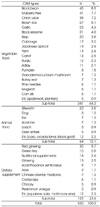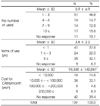Abstract
The purpose of this study was to investigate the perception and utilization of Complementary and Alternative Medicine (CAM) for diabetic patients in Busan. The subjects were 227 patients at two general hospitals (over 400 bed). This study was performed through the interviewing process using questionnaires conducted from January to April, 2010. Of a total of subjects, 109 patients (48.0%) had taken CAM at least one time. The patients used CAM recognized that they were 'auxiliary medicines' (39.4%), 'supplementary health foods' (32.1%) and 'medicines' (19.3%), but inexperienced patients perceived them as 'supplementary health foods' (29.6%), 'unscientific treatment' (22.6%) and 'medicines' (20.2%), It was significantly different between two groups of patients (p < 0.001). The number of CAM types used for the patients was 51. The CAM types were plant foods (64.3%), dietary supplement (23.6%) and animal diets (12.1%). The patients used an average of 5.9 different kinds of CAM and an average of 3.8 years them and paid \93,345 per month. The patients with diabetic complications and for longer morbidity periods used CAM for significantly (p < 0.05) longer periods. The mean effectiveness scores of the patients used CAM were 3.31/5.00 for efficacy satisfaction, 3.58/5.00 for fewer side effects compared to those of oral drugs, 3.60/5.00 for psychological stability, 3.81/5.00 for easiness to use, and 3.06/5.00 for economic satisfaction. Of the patients that used CAM, 55.9% did not consult with doctors about CAM. More than two-thirds of the patients (77.1%) did not feel the need to consult with doctors.
Figures and Tables
Table 6
The number of used and terms of use of CAM2) by morbidity periods and diabetic complication with experienced patients

References
1. American Diabetes Association. Standards of medical care in diabetes. Diabetes Care. 2009. 32(Suppl 1):S13–S61.
2. Barr EL, Zimmet PZ, Welborn TA, Jolley D, Magliano DJ, Dunstan DW, Cameron AJ, Dwyer T, Taylor HR, Tonkin AM, Wong TY, Mcneil J, Shaw JE. Risk of cardiovascular and all-cause mortality in individuals with diabetes mellitus, impaired fasting glucose, and impaired glucose tolerance: the Australian diabetes,obesity, and lifestyle study (AusDiab). Circulation. 2007. 116(2):151–157.
3. Bell RA, Suerken CK, Grzywacz JG, Lang W, Quandt SA, Arcury TA. Complementary and alternative medicine use among adults with diabetes in the United States. Altern Ther Health Med. 2006. 12(5):16–22.
4. Chae BJ, Song BJ, Kim SS, Kim SK, Jun KH, Song KY, Chin HM, Kim W, Park CH, Park SM, Lim KW, Kim SN, Jeon HM. Use of complementary and alternative medicine by gastric cancer patients. J Korean Surg Soc. 2007. 72(5):369–378.
5. Cho MR, Choue RW. A study of folk remedies in type 2 diabetic patients. Korean J Nutr. 1998. 31(7):1151–1157.
6. Cho NH. Prevalence of diabetes and management status in Korean population. Korean J Med. 2005. 68(1):1–3.
7. Choi YJ, Chung HW, Choi SY. A study on the use of alternative medicine for cancer patients admitted at a hospital. J Korean Public Health Assoc. 1998. 24(1):167–181.
8. Clifford RM, Batty KT, Davis W, Davis TME. Prevalence and predictors of complementary medicine usage in diabetes study. J Pharm Pract Res. 2003. 33(4):260–264.
9. Hollander JM, Mechanick JI. Complementary and alternative medicine and the management of the metabolic syndrome. J Am Diet Assoc. 2008. 108(3):495–509.
10. Kim KR. Diabetes mellitus and folk remedy-actual condition and problem. Proceedings of 1996 Symposium of Korea Diabetes Assoc. 1996. 113–118.
11. Kim YS, Chun JH, Park JH, Kang CI. Status and associating factors of complementary and alternative medicine among Korean diabetic patients. J Korean Diabetes Assoc. 2000. 24(1):78–89.
12. Annual report on the cause of death statistics in Korea. Korea National Statistical Office. 2008. Available from http://www.kostat.go.kr.
13. Lee HS, Lee JS, Lee HP, Jeon CE. Diabetes, depression and doctor- patient relationship. Korean Diabetes J. 2009. 33(3):178–182.
14. Lee KW, Hong SB, Min KY, Lee SY, Nam MS, Kim YS, Ahn CW, Cha BS, Kim KR, Lee HC, Lee KW, Park TS. Resurvey of alternative medicine in Korean type 2 diabetes mellitus after 10 years. J Korean Diabetes Assoc. 2005. 29(3):231–238.
15. Lee MS. A survey of utilization of complementary alternative medicine in diabetes mellitus. J Korean Acad Nurs. 2001. 31(1):7–19.
16. Ministry for Health, Welfare and Family Affairs. National health & nutrition survey. 2008. 52–54.
17. Nam MS, Lee KM, Park HY, Huh KB, Lee HC, Lim SK, Lee EJ, Kim KR, Cho JH. A study on the folk remedies by the questionnaries in Korean diabetic patients. Korean Diabetes J. 1994. 18(3):242–248.
18. Mikhail N, Wali S, Ziment I. Use of alternative medicine among Hispanics. J Altern Complement Med. 2004. 10(5):851–859.
19. What is complementary and alternative medicine? National Center for Complementary and Alternative Medicine. 1998. Available from http://altmed.od.nih.gov/nccam/what-is-cam.
20. Al-Rowais NA. Herbal medicine in the treatment of diabetes mellitus. Saudi Med J. 2002. 23(11):1327–1331.
21. Ock SM, Choi JY, Cha YS, Lee JB, Chun MS, Huh CH, Lee SY, Lee SJ. The use of complementary and alternative medicine in a general population in South Korea: results from a national survey in 2006. J Korean Med Sci. 2009. 24(1):1–6.
22. Park SJ. Experiences of the complementary and alternative medicine among the diabetic patients in rural area. 2003. Inje University;6–10. MS thesis.
23. Yoon TH. Affecting factors of complementary and alternative medicine use by patients in a rheumatology hospital in Seoul. 2004. Seoul National University;9–13. MS thesis.
24. Zimmet P, Alberti KG, Shaw J. Global and societal implications of the diabetes epidemic. Nature. 2001. 414(6865):782–787.




 PDF
PDF ePub
ePub Citation
Citation Print
Print









 XML Download
XML Download